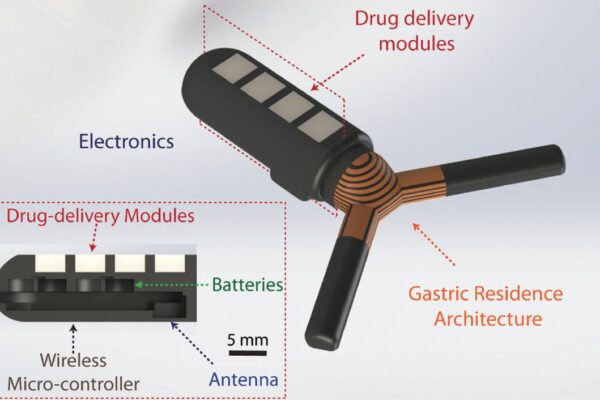
Electronic pill unfolds in the stomach for longer stays
For controlled drug delivery and health monitoring, an alternative consists in designing sensor-laden and drug-carrying pills that can be swallowed, though their stay in the stomach is rather transient, usually lasting only a day or two before being excreted.
Now, researchers from the Massachusetts Institute of Technology have designed an electronic pill that unfolds when it reaches the stomach, preventing it from following its natural course through the gastrointestinal route. On the mechanical side, the Gastric Resident Electronic (GRE) system as it is called (because it remains in the gastric cavity for up to a month), consists of a 3D-printed elastomeric shape whose arms are folded back along the pill’s main body into a gelatin capsule. After ingestion, the gelatin dissolves within seconds in the gastric fluid and the arms expand again, somehow anchoring the pill within the stomach so its sensors and multiple drug carriers can operate for longer within the human body.
In a paper titled “3D-Printed Gastric Resident Electronics” published in Advanced Materials Technologies, the researchers report Bluetooth-enabled GRE prototypes lasting up to 36 days in the hostile gastric environment, maintaining their wireless connectivity for about 15 days.
Measuring the actual radio signal from the ingested pill, the authors report a stable transmission at 2.4GHz and the possibility to directly interconnect the electronic pill with external devices such as Bluetooth-enabled wearables and smartphones while simultaneously restricting the signal strength to within an arm’s length (−80 to −90 dBm at 45 cm) to provide a physical isolation for additional security and privacy protection.
The Gastric Resident Architecture (GRA) which is the real novelty here, was designed through additive manufacturing using a biocompatible poly-l-lactic acid (PLA) and a thermoplastic polyurethane. The arms eventually detached after over a month being subjected to the gastric fluid, but in the future such reconfigurable structures could incorporate a pH-responsive enteric elastomer (resistant to acidic environments) which could dissolve in the neutral-pH environment of the small and large intestine.
The researcher also developed different ways of externally triggering the dissolution of different linker segments to accelerate the pill’s transit, in case the macrostructure should be excreted earlier due a patient’s adverse reaction to the treatment.

showing its unfolded architecture, the integrated
electronics and the personalized drug delivery modules.
Since 3D printing allows the co-integration of drugs formulated with distinct programmable release profiles in a hydrophobic biodegradable matrix, the research also included the testing of delayed drug release. Because the GRE is retained in the stomach for several weeks, drug release can be prolonged and precise constant dosages were proven to be feasible.
The author envisage that such a platform could be designed to achieve electrically modulated drug delivery (through an electroactive adhesive) in addition to tailoring the polymeric matrix to achieve a range of drug release profiles.
In the future, they hope that such long-resident custom drug delivery devices could be manufactured digitally at local healthcare facilities by physicians and pharmacists, enabling personalized remote diagnostic and automated therapeutic strategies. Connecting to the patient’s wearables via Bluetooth, the gastric resident electronic system could communicate data and be controlled directly by health care providers without specialized equipment. This would support real-time feedback-based automated treatment or responsive medication the authors conclude.
MIT – www.mit.edu
 If you enjoyed this article, you will like the following ones: don't miss them by subscribing to :
eeNews on Google News
If you enjoyed this article, you will like the following ones: don't miss them by subscribing to :
eeNews on Google News



